#winton formation
Text


And so here is the result of the Winton Formation stream!
Home of Australovenator, a bunch of sauropods and lots of other critters. Preserved in this formation are the animal of a coastal river system.



Have some detail shots as well
#sciart#paleoart#paleostream#palaeoblr#cretaceous#dinosaur#dinosaurs#pterosaur#sauropod#australovenator#winton formation#australia#diamantinasaurus
718 notes
·
View notes
Text









Autistic Headcanon ► Jamie Winton (You, Me, & The Apocalypse)
#jamie winton#autism headcanon#autistic headcanon#you me and the apocalypse#ymata#ymataedit#mat baynton#mathew baynton#mari's stuff#this doesn't include everything i wanted to include#but i really like this format and there's only 9 gifs ahahah
60 notes
·
View notes
Text
Homopodex bicrista
quick life recon and skeletal of the recently described Homopodex bicrista, described by Fa and Tass, (2024).

Shi Tass notes various novel features that give us a better understanding of alanqid anatomy: "being an alanqid it posesses two knobs on its top jaw. however it possesses three novel features: two head crests, raised spinous processes, and an incredibly reduced tail"
"while the use of the raised spinous processes is unknown, we know that the reduced tail would've resulted in the muscles 'bundling' up at the hips almost created a human-like butt shape"
Fa and Tass acknowledged that both of these traits need further study.
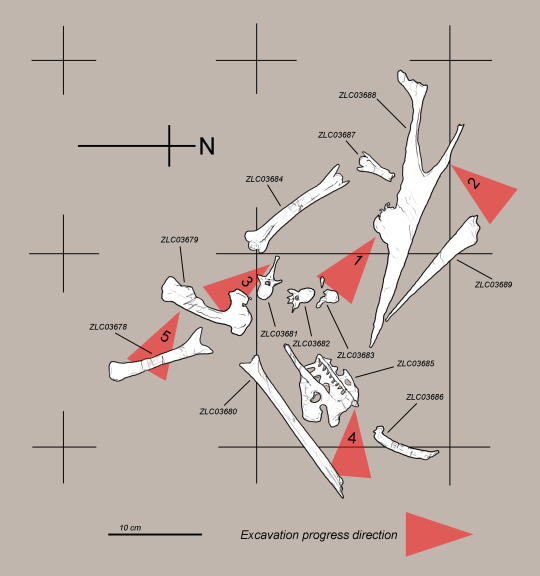
Yuri Fa gave more contextual information: "the holotype ZLC 036 was recovered in the Winton Formation; Australia, and is now the second azhdarchomorph specimen known from the country"
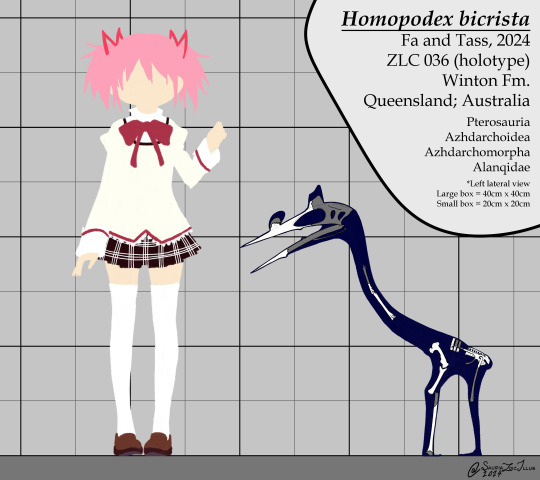
𝗮𝗹𝘀𝗼 𝗵𝗮𝘃𝗲 𝗮 𝗵𝗮𝗽𝗽𝘆 𝗔𝗽𝗿𝗶𝗹 𝗲𝘃𝗲𝗿𝘆𝗼𝗻𝗲!
#april fool's day#april fools#paleontology#paleoart#digital art#artists on tumblr#digital artwork#palaeoart#digital illustration#sciart#palaeoblr#paleoblr#pterosaur#skeletal#Homopedax#Homopedax bicrista
95 notes
·
View notes
Text
Round Two: Ibirania vs Australotitan
Ibirania parva

Artwork by @i-draws-dinosaurs, written by @i-draws-dinosaurs
Name meaning: Little wanderer of Ibirá (a municipality of São Paulo, Brazil)
Time: ~85 to 72 million years ago (Santonian to Campanian stages of the Late Cretaceous)
Location: São José do Rio Preto Formation, Brazil
Enormous sauropods keep making the news as the next giant behemoth, stacking up a roster of incredibly huge animals that push the limits of how big a land animal can get. But every now and then, a sauropod comes along that is just a certified Little Guy, and that is Ibirania! Described in 2022 as a new genus of saltasaurine, Ibirania is remarkably little even within this modest-sized clade. It clocks in at under 6 metres long and only a couple heads taller than the average human, which also makes it an extremely temptingly rideable size. Like that’s just a less messed up horse with some slightly more uncomfortable armour plates! Another unique feature of Ibirania is the evidence for acute osteomyelitis in the leg of one specimen, an example of one of the many diseases that could and did affect dinosaurs throughout their probably pretty difficult lives. Not only that, but there are preserved blood parasites inside the leg bone that would have caused the infection, a definite first in dinosaur paleontology! Kinda sucks for the dinosaur, but also fascinating stuff!
Australotitan cooperensis

Artwork by Vlad Konstantinov, written by @i-draws-dinosaurs
Name meaning: Southern titan from Cooper Creek
Time: ~95 million years ago (Cenomanian to Turonian stages of the Late Cretaceous)
Location: Winton Formation, Australia
Nicknamed “Cooper” by its discoverers in 2005, Australotitan was big news on the Australian dinosaur scene for years before its discovery because it was clear this dinosaur was Huge. It took 5 years of preparation and 10 years of study and reconstruction before Cooper was finally published in 2021, and secured its official title as the largest Australian dinosaur known to science! While exact weight measurements for titanosaurs are extremely difficult, it fits into the same size class as other newly-famous giants like Dreadnoughtus and Patagotitan. The bones themselves show signs of being trampled over by a convoy of smaller sauropods that left a 100 metre fossil trackway over the site. Honestly, the disrespect to an icon like Cooper!
#dmm#dinosaur march madness#dinosaurs#birds#dmm rising stars#birblr#palaeoblr#paleontology#dmm round two#bracket#march madness#polls#ibirania#australotitan
174 notes
·
View notes
Text
Fossil Crocs of 2022
For what its worth, its been a great year for fossil Pseudosuchians, many of which didn't get a lot of attention because people always assume its just "another crocodile". We'll go through them by the order of appearance in the fossil record, or in other words oldest to youngest. Better grab some popcorn and the drink of your choice, cause this is going to be a long one.
Mambawakale
Starting off is Mambawakale ruhuhu (Ruhuhu Basin Crocodile Ancestor in Kiswahili) from the middle Triassic Manda Beds of Tanzania. The fossils for this guy had been known since at least the 1960s, after which it was named Pallisteria angustimentum, a name that was never officially published however. It was a large animal, its skull 75 centimeters long attached to what was likely an animal similar in build to what we think of for "rauisuchians", given that it sits at the base of Paracrocodylomorpha. The below life reconstructoin was done by the fantastic Gabriel Ugueto with Steve Irwin inserted in post by me, tho its not rigorously scaled it gives a general idea of the animal's size.
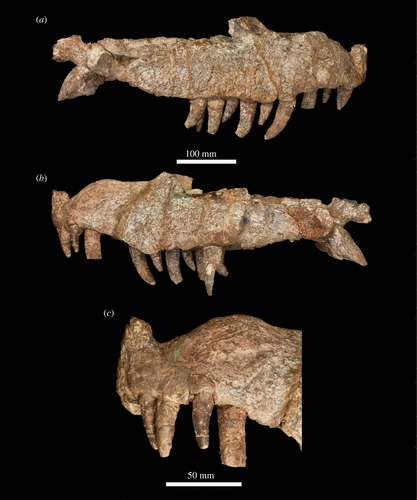
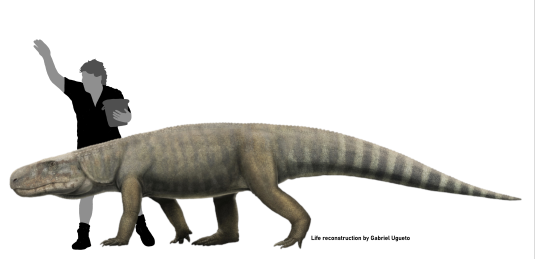
We can then skip over the Jurassic (no new crocs from that period) and straight into the Cretaceous, specifically the Albian some 100 million years ago.
Yanjisuchus
Yanjisuchus longshanensis (Yanji City Crocodile from the Longshan Hill) was a paralligatorid, a group of Neosuchians I fully admitt I'm not too well aquainted with. Its fossils, which include a partial skull, vertebrae osteoderms, ribs, parts of the shoulder girdle and front limbs, were discovered in the Longjing Formation in what is now north-eastern China.

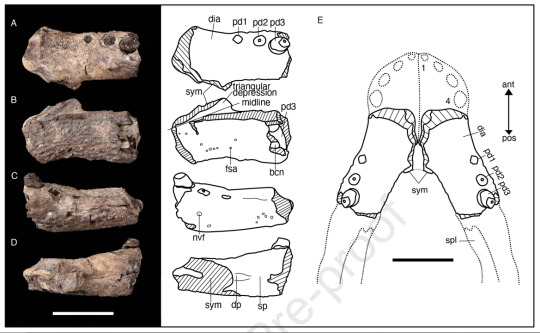
Confractosuchus
One I can decidedly talk more about is Confractosuchus sauroktonos (Lizard Eating Broken Crocodile) from the Australian Winton Formation, home to animals such as Isisfordia, Australovenator and Diamantinasaurus. The genus name refers to the fact that the skull is squashed to hell and back, but its the species name thats interesting. "Lizard eating" in this case refers to the fact that this 2.5 meter long basal Eusuchian was found with preserved stomach contents. Said stomach contents being the bones of a small ornithopod dinosaur as the press release art by Julius Csotonyi enthusiastically shows. The other image here not from the paper was drawn by Joschua Knüppe (@knuppitalism-with-ue ) showing a definitely more relaxed individual.

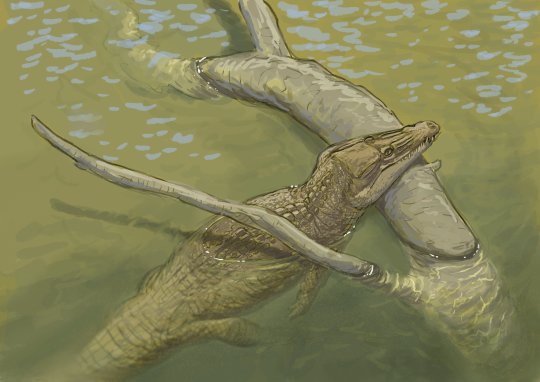

Eptalofosuchus
We did know about this guy for a bit longer as the pre-proof has been out since 2021, but lets include it anyways because I wasn't on Tumblr last year. Eptalofosuchus viridi (Green Seven Hills Crocodile) is not a crocodile in the strict sense but a Notosuchian, a cousin to the more typical Neosuchians. This animal is known from a single distinct lower jaw that belonged to a rather small creature. Among Notosuchians, Eptalofosuchus is most closely related to "advanced Notosuchians", specifically Sphagesauridae. We also know that it wasn't alone, as described alongside it are fossils of an unnamed baurusuchid (a large carnivore) and a peirosaurid, a more basal Notosuchian. Finally, both parts of the scientific name allude to the Uberaba Formation, specifically the nickname of Uberaba being “the city of the seven hills” and the green color of the sediments there. Life reconstruction of the little guy was done by the always incredible Júlia d'Oliveira.
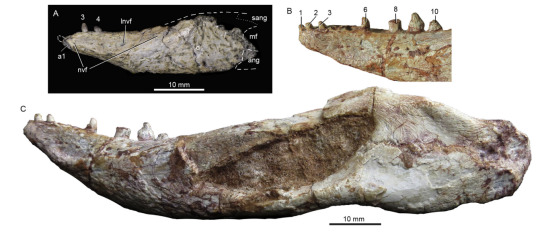
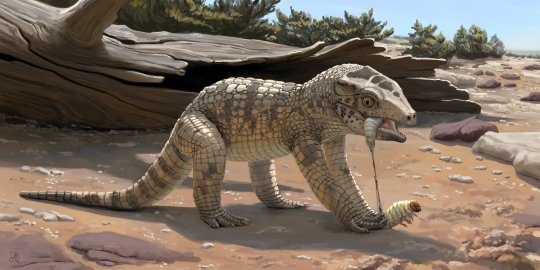
Titanochampsa
Sticking to South America we have Titanochampsa iorii (Ior's Titan Crocodile). A significant find no doubt tho with an estimated size between 2.98–5.88 m (sizable I admitt) based on very scant remains perhaps a little bit hasty. Alas we only have the skull table of this animal, so the precise size can still vary as you can see. But it is still a fascinating one due to the fact that its the ONLY non-Notosuchian from the Bauru Group. Cretaceous South America is almost synonymous with these mostly terrestrial crocodyliforms but surprisingly lacking a diverse semi-aquatic croc fauna. Being at the very least a Neosuchian, possibly Eusuchian, Titanochampsa seems to have filled this niche. Given that the big terrestrial Baurusuchids had relatively weak bites and reached a length of at most 4 meters, this presents an interesting contrast with the strong bite force of the potentially larger semi-aquatic Titanochampsa. And would you look at that, press release art by Júlia once again.
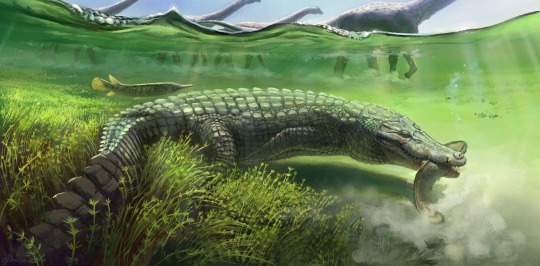

Eurycephalosuchus
One final croc for the Mesozoic, Eurycephalosuchus gannanensis is an animal I covered very recently so I'll keep things brief. Stemming from the Maastrichtian Hekou Formation in south eastern China, Eurycephalosuchus was a very small species of orientalosuchine. Orientalosuchina is recovered as a group of early alligatoroids in the paper, tho talking to Adam Yates (who's croc phylogeny is my go-to) there is a chance they might be closer to crocodiloids. Regardless, Eurycephalosuchus was a small animal with large teeth towards the front of the skull, blunt teeth in the back and an overall very short face (tho there is slight compression so its not 1:1 like the fossil). Over on twitter people started comparing it to DnD Kobolds, leading to the below artwork by Manusuchus (@ mmujicam2000; full body of course highly speculative lmao)
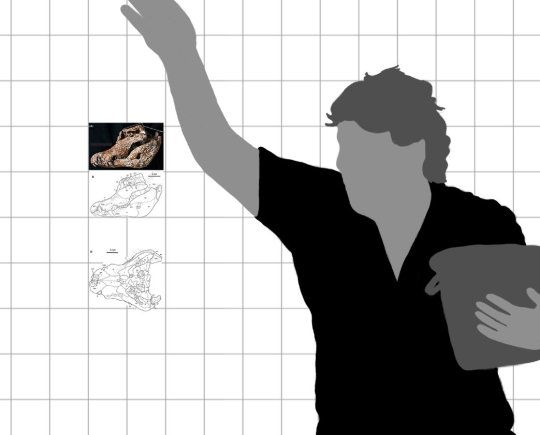

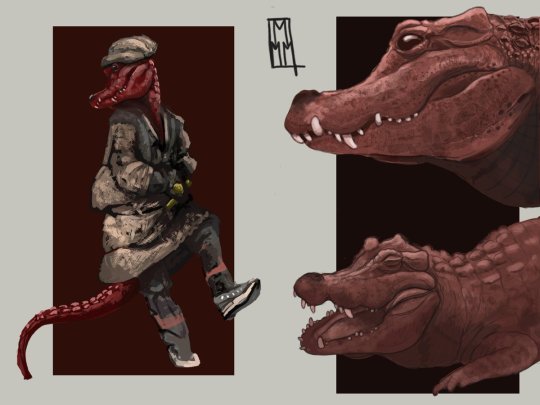
Qianshanosuchus
Following the cataclysm that was KPG, crocs held on and in China we next meet Qianshanosuchus youngi (Young's Qianshan Basin Crocodile). It's another tricky one. While important as being the first crocodyloid from Paleocene China, the material, as you could guess based on the tiny size, is that of a juvenile (I now realize this being kinda ironic given the small but adult croc above). So the phylogeny is hard to nail down and gave different results. Still it could hold significance in our understanding how crocodyloids spread around the world and entered Europe after KPG. Below a quick comparison of the material with my hand.

Coming up a duo of two new species but not new genera, I also didn't really go deep into their publication as with some of the others so I'll try to stay brief
Maomingosuchus acutirostris
Maomingosuchus acutirostris (Acute Snouted Maoming Crocodile) is a new species of the already established genus Maomingosuchus from China. This new species however, differentiated amongst other things by having a pointed, not rounded, premaxilla stems from the Eocene of northern Vietnam. The skull is about 55 cm long giving us a medium sized tomistomines. Like Qianshanosuchus, M. acutirostris could have implications for the dispersal of crocodilians, in this case the spread of tomistomines from Europe to Asia, which the authors suggest happened thrice. That being said it should be noted that, between the two main ideas of what tomistomines are, the paper goes with them being a sister group to crocs and unrelated to modern gharials as Lee and Yates suggest (the later idea like I said I am more drawn towards).


Diplocynodon kochi
Another new species in a familiar genus, Diplocynodon kochi (Koch's Double Dog Tooth) is the latest in a long list of Diplocynodon species, a genus of alligatoroid very prominent in the Paleogene of Europe. This newest species from Transylvania is known from some well preserved skull material and was recovered as being one of the most derived members of its genus. With a size of 1.76 meters it was a medium sized Diplocynodon species and small by our modern standards. What is interesting is that the fossilw as recovered from shallow marine sediments. This is unusual in so far that alligatoroids are not especially known for their salt tolerance. Tho there's exceptions like Deinosuchus, alligators usually don't venture into salt water unlike crocodiles. Still, given the shallow water and the ability of large adult Mississippie Alligators to tolerate brackish water, it might have occasionally entered coastal waters. It is noted that the skull is in such good condition that it couldn't have been transported for a very long time.
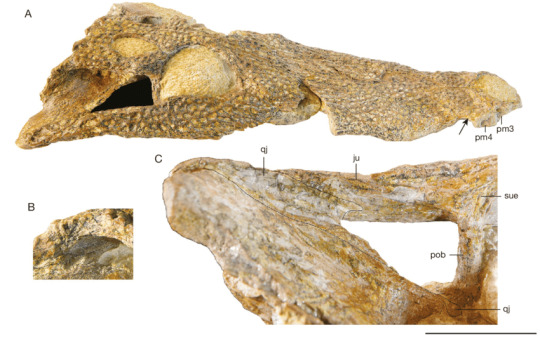
Kinyang
Back to new genera we got Kinyang (derived from various Nilotic terms for crocodile), a genus of "giant" dwarf crocodile from the Miocene of Kenya. Now this guy doesn't just introduce one new species but two: Kinyang mabokoensis (Maboko Island Crocodile) and Kinyang tchernovi (Tchernov's Crocodile). Occuring in western and northern Kenya, Kinyang was a prime example over the prominence osteolaemines (dwarf crocodiles) had in the early Cenozoic prior to the takeover of crocodylines. Kinyang was surprisingly large and had a robust, blunt skull with several traits clearly setting it apart from any modern species. Still there is some clues that could be taken. Given the robust nature and more widened skull rather than V-shaped, its likely that it went after prey as big or even bigger than itself. They appear to have inhabited the shores of lakes located in open forests and woodlands. Alas this might have been their doom too. Osteolaemines are known to build nests made of foliage and with Africa growing increasingly dryer around this point in earths history, both change in prey and environment could have been factors that drove the dwarf crocodiles into the rainforests they inhabit today while the more dry resistant Crocodylus took over their rolle in the grasslands. The first image shows all three known skulls, the second is a quick composite of the cranium and mandible of K. mabokoensis I put together before the third image was published (ironic) by Christopher Brochu.
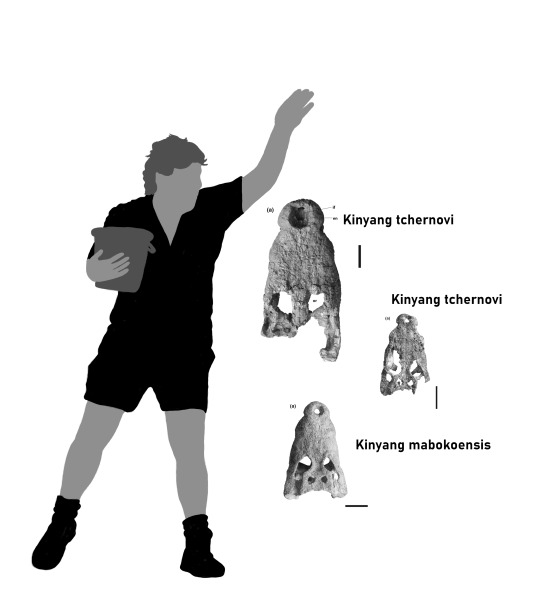
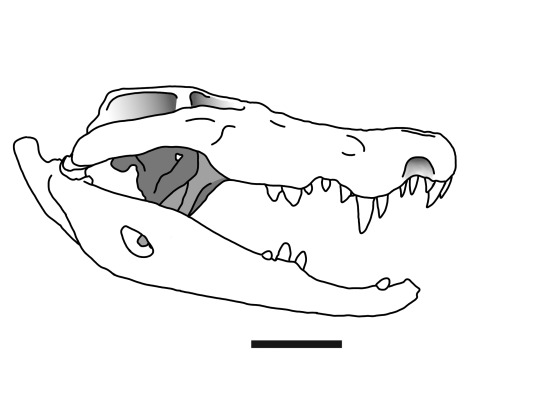

Almost done, only two more to go.
Sacacosuchus
On the other side of the world, specifically the Sacaco locality of Peru's Pisco Formation (among others) we have Sacacosuchus cordovai (Córdova's Sacaco Crocodile). A medium sized and longirostrine "tomistomine" gharial, here is where we come in conflict between the crocodylid and gavialoid model of what these guys are. Earlier with Maomingosuchus you had the idea that tomistomines were related to crocodylids, well here we have tomistomines being a paraphyletic group leading up to derived gharials. There is some significance to Sacacosuchus for seemingly showing that gharials entered South America on two separate occassions, but imo that's not the coolest thing about it. No instead I prefer to talk about the fact that its not just a marine gharial, living in the coastal waters of the Pacific, but that it coexisted with a second gharial showing perfectly how they specialise in different things. While the contemporary Piscogavialis was notably larger (about 7 meters) it had a very narrow and long snout, better adapted at catching fish. Sacacosuchus meanwhile was only 4.3 meters long, but with much more robust jaws, showing that it was much more of a generalist than its relative. This is well shown in the reconstruction by Javier "Canelita" Herbozo, tho it doesn't show the immense size difference. The third iamge shows Rodolfo Salas-Gismondi with the material and the fourth illustration by Gabriel Ugueto does not feature Sacaco, but the much more gracile Piscogavialis.




Hanyusuchus
The final one, Hanyusuchus sinensis (Han Yu's Crocodile from China) is the youngest crocodile described this year. How young? Well the OLDEST records of the species date to the Chinese Bronze Age, 4.000 BC, while the most recent records indicate that it went extinct in the 15th century. Hanyusuchus is a large tomistomine with a length between 5.43–6.19 meters and, if historical reports are to be believed, a big appetite. Stories tell of large crocodiles in Southern China attacking livestock, deer, boats and even killing humans while other reports suggest that these animals were used to fill moats and fed with prisoners. Despite appearing relatively narrow snouted, people often underestimate just how dangerous such animals could be. Even the modern false gharial has reports of it attacking and eating humans. Unsurprisingly, in addition to spawning some unique folklore (like crocodiles turning into tigers during autumn), this lead to humans attacking and killing these animals in retaliation. Fossils from the Bronze Age bear the clear marks of human attacks with cut marks focused around the animals head and the neck. Given the age of this material humans likely used bronze axes to kill and decapitate Hanyusuchus, drying their heads afterwards. Things didn't get better later in history. Han Yu, poet and politician and namesake of the genus, once demanded that the crocodiles leave the Han River delta before threatening to kill them. Later in history soldiers were sent to kill them in masses to avenge the death of a child. Eventually all of this, coupled with habitat loss, lead to the extinction of Hanyusuchus a mere 600 years ago. The below reconstructions were done by Hikaru Amemiya and Joschua Knüppe respectively.


And that is basically every crocodile officially published in 2022 (I think). Personally, I think its been a fantastic year for Pseudosuchian taxa, with some unique and fascinating additions.
#crocodiles#palaeoblr#mambawakale#hanyusuchus#sacacosuchus#kinyang#qianshanosuchus#eurycephalosuchus#diplocynodon kochi#maomingosuchus acutirostris#titanochampsa#confractosuchus#eptalofosuchus#yanjisuchus#prehistory#paleontology#pseudosuchia#steve irwin for scale#2022
173 notes
·
View notes
Text
Sunday 5th March 2023
Yesterday's trip is still on our minds and the 180km section of the Matilda Highway between Winton and Longreach still seems incredible to the sensitivities of a delicate English disposition. One long straight road; no deviation and not a single property in sight. Not one!
The overnight stop in our Motel was as endurable as it was practical. Fundamentally we were not there to experience the joys of Barcaldine, a fair town in its own way I'm sure. We were there to break the journey before removing ourselves to Emerald. In penance perhaps for this attitude we were awakened at 6.30am by road train rigs thundering along the highway that brushed past the reception office nearby and the lady on the little electric buggy that plied around the cabins knocking doors as she delivered breakfasts. Couple this too with the sounds of happy tradies with their early start to the day closing cabin doors and firing the diesel pick-ups, off to earn an honest day's crust. Altruism comes in many forms and the gift of life is prescious and all frogs need a helping hand from time to time. So it was for the very small animal of this species spotted desperately paddling around the swimming pool as we enjoyed breakfast. Clearly he couldn't get out unassisted so, knowing deadly things exist on this continent, a coffee mug worked adequately to beam him up and out into his future. One life saved.
Now I have to confess that I might have been hasty in condemning Barcaldine too quickly. It was on inspection quite a fair little town with a bit of history to it. It sits on the Tropic of Capricorn for a start. It is perhaps best known for its links with the great Shearer's Strike of 1891 and what a to do that was as you well know. This was seen as the first major industrial dispute in Australia. Wool prices were falling and pastoralists were proposing dropping the shearers wages from £1 per 100 sheep shorn if the employer was not happy with the work done. This didn't go down well so the Shearers Union and the Queensland Labourers Union met in Barcaldine to set up a strike committee. Much discussion took place, talks broke down, employers brought in scabs who were protected by the police and militia and it sort of went down hill from there. 1500 shearers met these forces arriving by train. Both sides were armed but few shots were fired. An armed uprising was avoided but 13 strike committee members and leaders were arrested and jailed. With them out of the way the strike lost its direction but agreement was reached resulting in the union being recognised but no more pay and the pastoralists were still able to employ non union members. The longer term result of this conflict was the formation of the Workers Political Party the following year, and hence the first Labour party in the World. As a symbol of the struggle the Tree of Knowledge (Ghost Gum tree) was planted outside of the Railway Station. Sadly someone poisoned it in 2006 and a new one was planted by the union hall. Well good old Barcaldine played a really important role in Australian history.
Driving out of Barcaldine a large roadside sign said Speedo Checks - 10kms. Do they check the elastic?
Further down the Capricorn Highway We came into Jericho. A sleepier place you could not imagine. A ghost town with tumble weed might be an appropriate image. Jericho achieved its name because it is built on the Jordan River. The town commissioned a very charming sculpture called the Crystal Trumpeters depicting the story of Joshua and the walls tumbling down at the sound of trumpets. A very unusual and unexpected piece of imaginative art for such a small place. We pushed on, stopping briefly in Alpha for lunch. (No omega as far as I could see) filling up with petrol since the notice informed us there was no more fuel for 135kms and we were a bit low! Carrying on we crossed the stunning Drummond Range, such different scenery after hundreds of miles of bush.
Now sitting outside our room for the night enjoying a glass or two of SB at the latest in our collection of Motels, this one in Emerald. Can't say I like it much, for some reason there's lots of noisy kids about, but it is only one night after all! I suspect the whole bottle will go.



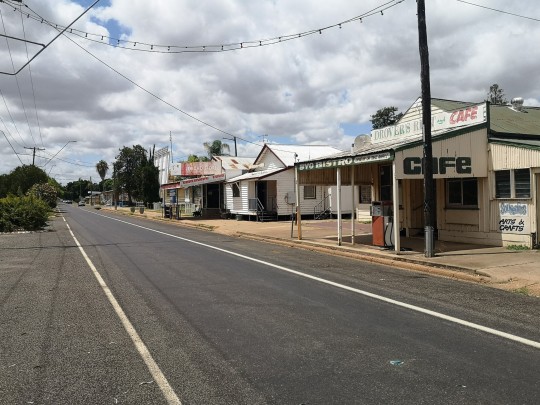


3 notes
·
View notes
Text
Dark Data: The future of Information Security
What interested me the most in picking this topic was that it gave me the initial thought that it would have the same meaning as the dark web. Surprisingly, in line with the research conducted, it was discovered that the Dark web and Dark Data have totally different meanings.
The dark web is a hidden part of the internet that can only be accessed with the Tor browser. You must know the precise address of the website you wish to access because dark web pages do not show up when you search for them in search engines. Typically, this area of the internet is referred to as "dangerous." The dark web is often stereotyped as where illegal actions like the sale of illegal substances and the employment of assassins occur. Even if the dark web is home to more than simply illegal marketplaces, there are still risks there.
For journalists and whistleblowers, the dark web can be a secure platform for unrestricted communication. In contrast, Dark Data is the summation of all unutilized, unexploited, and untapped data in a company that is produced by users' daily interactions with numerous devices and systems online, including machine data, server log files, and unstructured social media data. Organizations might view this data as obsolete, redundant, incomplete, or restricted by a format that cannot be used with current technologies. They frequently are not even aware that it exists.
Dark data, however, might be one of a company's most valuable untapped resources. Bridging the Gaps – “Dark Data: Why What You Don’t Know Matters” with Professor David Hand

This write-up will dwell more on Dark Data: Why what you don’t know matters with Professor David Hand: Home - Professor David Hand (imperial.ac.uk). Professor David Hand, who formerly held the Chair in Statistics, is an Emeritus Professor of Mathematics and Senior Research Investigator at Imperial College, London. He has held (twice) the office of President of the Royal Statistical Society and is a Fellow of the British Academy and an Honorary Fellow of the Institute of Actuaries. He served on the European Statistical Advisory Committee and as a non-executive director of the UK Statistics Authority for eight years. He serves as the chair of both the ONS's Centre for Applied Data Ethics Advisory Committee and the National Statistician's Expert User Advisory Committee. He has served as the UK's Administrative Data Research Network's Chair as well as the Research Board Chair of Imperial College's Data Science Institute. He served as Winton Capital Management's Chief Scientific Advisor for eight years. In addition to 32 books, he has authored 300 scientific papers.
As we all know, data collection can be automated, and this can take various forms, which are included in the types of dark data. Dark data can vary in various types namely:
Log files (servers, systems, architecture, etc.)
Previous employee data
Financial statements
Geolocation data
Raw survey data
Surveillance video footage
Customer call records
Email correspondence
Notes, presentations, or old documents.
According to a recent survey by Splunk, 55 % of data gathered by companies is classified as dark. That means more than half of the data collected never gets used.
Here is a scenario, for instance, there is a need for an individual to check their account balance through a mobile banking application; the individual might think that they are only providing their credentials, but in reality, they are actually generating larger amounts of other data such as their login time and data location, date, browser used and IP address this data often ends up being stored for regulatory reasons only and is rarely used for any other purpose including Business Intelligence Analytics and this is how dark data comes to light.
There are some useful importance and risks associated with dark data. Over recent years, companies have realized that the value of leveraging dark data could be enormous; if executed correctly, it could yield impressive insights and results.
Importance of Dark Data
Discover insight from hidden data: For a better group, companies can utilize dark data to identify crucial insights that would have otherwise remained hidden.
Diversify your data analysis: Insight tends to be more relevant, accurate, and precise when the original data source is more relevant, precise, and accurate. If companies want more comprehensive and quality results, they need to expand their boundaries and begin investing in their dark data because dark data includes unstructured and non-traditional data. It offers unique contributions to the raw data pool and business pipeline.
Associated Risk of Dark Data
Unspecified source and authenticity of the data: Dark data is left unmanaged, unregulated, and unorganized. It is more susceptible to data contamination than active data; this makes it difficult to evaluate the validity, authenticity, and source of dark data and its derivation insights which can cause monetary or brand value losses as well as companies concern.
High Storage Cost: If companies are not actively managing, analyzing, and leveraging their dark data, it simply becomes clutter that takes up valuable space; whether it is slowing down your servers or cluttering your cloud storage, a growing amount of dark data will increase your storage and maintenance cost as well. With that being said, the best approach for businesses to take is to either delete or convert their dark data.
Conclusion
As new computing methods for data processing are developed, reports indicate that the value of dark data will increase. Technological advances are facilitating the economic utilization of this dark data, but numerous businesses are yet to recognize its significance of dark data.
In healthcare and education, for instance, vast volumes of data might generate a substantial potential to serve patients and students in the same way that consumers and financial services seek their intended targets. To wrap up, dark data can yield valuable competitive and unique insights when managed and utilized correctly. As a result, leading business intelligence companies like Cubewave have developed tools and solutions for businesses to make the most of all their data dark or active.
Finally, to stay ahead of the curve in today’s increasingly saturated market, companies need to rethink their data strategy and invest in the right software to illuminate their dark data.
4 notes
·
View notes
Link
Pharmacology: A Patient-Centered Nursing Process Approach (11th Edition) - eBook eBook Details Authors: Linda E. McCuistion, Kathleen DiMaggio, Jennifer J. Yeager, Mary Beth Winton File Size: 126 MB, 75 MB Formats: ePub (original), PDF (converted) Length: 823 Pages Publisher: Saunders; Eleventh Edition Publication Date: December 11, 2021 Language: English ASIN: B09PF29H57 ISBN-10: 0323719350, 0323793169, 032382580X ISBN-13: 9780323793155, 9780323793162, 9780323881401, 9780323825801, 9780323793186
0 notes
Text

A stock photo shows a Dinosaur Fossil simulator excavation used for education. Researchers recently discovered the Fossil of a new Aetosaur Species in Texas. IStock/Getty Images
Extinct 'Eagle Lizard' Found in Texas Canyon
— Newsweek | January 19, 2023
Researchers recently learned that a fossil unearthed in 1989 was actually a new reptile species that lived roughly 218 million years ago in what is now a Texas canyon.
The newly identified species, Garzapelta Muelleri, is a type of Aetosaur, which means "Eagle Lizard" because the reptile's skull resembles that of a bird, according to a report by Sci.News. Like alligators, aetosaurs roamed wet regions across the supercontinent Pangea during the Late Triassic Period, the University of California Museum of Paleontology says.
The museum says the aetosaurs were heavily armored with a crocodile's body, pig's snout and bird's skull. The newly discovered reptile was up to 11.5 feet long, according to a study about the newly identified species that was published in The Anatomical Record on January 11.
Aetosaurs were believed to be omnivores and herbivores. They vanished at the end of the Triassic period because of a mass extinction event.
The aetosaur's fossilized skeleton was first found by Paleontologist Bill Mueller from Texas Tech University and local amateur collector Emmett Shedd in 1989 in the Cooper Canyon Formation in Garza County, Texas. But Mueller died in 2019, and many of his projects remained unfinished. William Reyes, a paleontologist and Ph.D. candidate at the University of Texas at Austin, was invited to lead the description of the new species that was published earlier this month in The Anatomical Record.
The skeleton was found along with the creature's carapace, a hard outer shell that is similar to that of a turtle. The study said that the carapace fossil provides "new insight" into carapace variation across the species and that the findings imply that researchers were "dealing with the emergence of a new group of aetosaur."
"Everyone agreed that it was indeed a new species, as it exhibited several unique features in its armor that differentiate it from any other known Aetosaur Species," Reyes told Newsweek. "However, where exactly it fell in the evolutionary tree of this group remained contentious."
Reyes said the next steps in his research include reassessing some of the aetosaur relatives of the Garzapelta Species.
Researchers believe that aetosaurs lived across the world, as their fossils have been found in Europe and North and South America, the University of California museum said. The most common aetosaur fossils that researchers find are the hard plates that make up the body armor, the report said.
The discovery comes after researchers found two new species of an "Iconic and Bizarre" dinosaur group in North America at the end of last year.
Earlier this month, a fossil found by a pair of hikers last year was identified as the skull of a huge new species of prehistoric fish that lived around 72 million years ago.
Researchers also announced the discovery of the remains of a large flying reptile that roamed Earth's skies 100 million years ago during the age of the dinosaurs.
In other locations across the world, scientists are finding that species they thought were extinct are still thriving in the wild, like the De Winton's golden mole in South Africa 🇿🇦 and the Attenborough's long-beaked Echidna in New Guinea 🇬🇳.
"I think it's just fantastic that...we can still rediscover species," said Cobus Theron, a member of the research team that found the golden mole, in a press release. "All of our stories around conservation are doom and gloom. Here we have an opportunity to say that, actually, there are opportunities to make change."
#Newsweek#Dinosaur Fossil#Extinct 'Eagle Lizard'#Fossil#Aetosaur Species#Texas | USA 🇺🇸#Texas Canyon#University of California Museum of Paleontology#Paleontologist | Bill Mueller | Texas Tech University#Garzapelta species#William Reyes | Paleontologist#University of Texas at Austin
0 notes
Text
Winton Woods Class Of 2024 SVG - Winton Woods Warriors SVG PNG, Cricut File
Winton Woods Class Of 2024 SVG, Winton Woods Warriors SVG PNG EPS DXF PDF, Cricut File, Instant Download File, Cricut File Silhouette Art, Logo Design, Designs For Shirts.
♥ Welcome to SVG OCEAN DESIGNS Store! ♥
► PLEASE NOTE:
– Since this item is digital, no physical product will be sent to you.
– Your files will be ready to download immediately after your purchase. Once payment has been completed, SVG Ocean Designs will send you an email letting you know your File is ready for Download. You may also check your Order/Purchase History on SVG Ocean Designs website and it should be available for download there as well.
– Please make sure you have the right software required and knowledge to use this graphic before making your purchase.
– Due to monitor differences and your printer settings, the actual colors of your printed product may vary slightly.
– Due to the digital nature of this listing, there are “no refunds or exchanges”.
– If you have a specific Design you would like made, just message me! I will be more than glad to create a Custom Oder for you.
► YOU RECEIVE: This listing includes a zip file with the following formats:
– SVG File (check your software to confirm it is compatible with your machine): Includes wording in both white and black (SVG only). Other files are black wording.
– PNG File: PNG High Resolution 300 dpi Clipart (transparent background – resize smaller and slightly larger without loss of quality).
– DXF: high resolution, perfect for print and many more.
– EPS: high resolution, perfect for print, Design and many more.
► USAGE:
– Can be used with Cricut Design Space, Silhouette Cameo, Silhouette Studio, Adobe Illustrator, ...and any other software or machines that work with SVG/PNG files. Please make sure your machine and software are compatible before purchasing.
– You can edit, resize and change colors in any vector or cutting software like Inkscape, Adobe illustrator, Cricut design space, etc. SVG cut files are perfect for all your DIY projects or handmade business Product. You can use them for T-shirts, scrapbooks, wall vinyls, stickers, invitations cards, web and more!!! Perfect for T-shirts, iron-ons, mugs, printables, card making, scrapbooking, etc.
►TERMS OF USE:
– NO refunds on digital products. Please contact me if you experience any problems with the purchase.
– Watermark and wood background won’t be shown in the downloaded files.
– Please DO NOT resell, distribute, share, copy, or reproduce my designs.
– Customer service and satisfaction is our top priority. If you have any questions before placing orders, please contact with us via email "[email protected]".
– New products and latest trends =>> Click Here .
Thank you so much for visiting our store!
SVG OCEAN DESIGNS
Read the full article
0 notes
Text

Following Winton, Man Group, Two Sigma, D. E. Shaw, Metori Capital, etc., the quantitative giant, well-known London hedge fund Aspect Capital plan to enter in China, will set up an office in Shanghai and register as a wholly foreign owned enterprise (WFOE). At present, the relevant Shanghai authorities are simplifying the process of registered capital for foreign institutional investors and facilitating foreign exchange management for foreign investors, and the adjustment of the policy is aimed at providing a more open environment for participation in the Shanghai market. These changes indicate that the Shanghai market will become more attractive to international investors, helping to promote the formation of long-term capital and the high-quality development of the market.
At present, Shanghai vigorously develops the economy and encourages domestic and foreign investors to take root in Shanghai. Shanghai Tannet can provide foreign company registration, representative office registration, bank account opening, work visa, notarization & authentication, annual report, accounting & tax declaration, trademark & bar code, patent & copyright, ODI, copywriting planning, website construction, corporate email, etc. Welcome to consult ~
0 notes
Link
Get the pharmacology steering confirmed to assist aspiring nurses succeed on the NCLEX and later as skilled nurse. Using a streamlined prototype strategy, an emphasis on nursing care, plus a wealth of different trademark options, Pharmacology: A Patient-Centered Nursing Process Approach, 10th Edition, (PDF) makes it straightforward so that you can actually perceive pharmacology. Prototype drug charts summarize the necessity-to-know details about key medicine, together with dosage, unwanted side effects, interactions, and extra. Images of present drug package deal labels reinforce your understanding of textual content content material utilizing related, true-to-life studying. Bulleted nursing course of summaries relate nursing care to drug remedy, highlighting affected person instructing, affected person security, and related cultural content material. Finally, the distinctive and thorough drug calculations part includes a math evaluation in addition to step-by-step directions for drug calculations utilizing the 4 normal strategies of dosage calculation. All in all, this textbook, Pharmacology, Tenth Edition, has all of the instruments you could perceive the sophisticated topic of pharmacology higher. Application-level NCLEX examine questions embody no less than one alternate-format query included per chapter. UNIQUE! Nursing course of summaries spotlight vital nursing issues inside the nursing course of framework. Consistent RN-commonplace chapter pedagogy contains: on-line studying assets on the companion Evolve web site, targets, and description. Prioritization protection all through the textbook helps you be taught to prioritize nursing care and differentiate want-to-know from good-to-know content material. UNIQUE! An intensive chapter on drug calculations presents six strategies of dosage calculation, offering a useful evaluation and complement to a dosage calculations textbook. Critical considering case research problem you to use your information and analytical abilities to lifelike affected person eventualities. Answer tips are offered on the Evolve web site. A chapter on security and high quality discusses medicine errors, particular nursing measures to advertise security, National Patient Safety Goals, and plenty of different issues of safety and issues. UNIQUE! Prototype drug charts present straightforward access to essential info for consultant medicine, together with dosages, contraindications, drug-lab-meals interactions, pharmacokinetics, and extra. NEW! Updated nursing processes have been added for consistency from chapter to chapter. NEW! New chapter on pharmacogenetics particulars how a affected person’s genetic make-up might have an effect on his or her response to medicine. NEW! New nursing ideas have been added to the nursing processes to assist conceptual studying and better-degree considering additional. NEW! Additional scholar evaluation questions have been added to arrange you for the rising pharmacology protection on the NCLEX Exam. NEW! Thoroughly up to date drug content material displays the most recent FDA drug approvals, withdrawals, therapeutic makes use of, and corresponding up to date nursing content material. NEW! Updated antihypertensive tips (printed in November 2017) guarantee you might be present on the most recent finest practices relating to medicine used to deal with hypertension. 978-0323642477, 978-0323654326, 978-0323749596, 978-0323750660, 978-0323759076 NOTE: This sale only contains the Pharmacology: A Patient-Centered Nursing Process Approach (10th Edition) - eBook in PDF. No access codes are included.
0 notes
Text
A new species of dinosaur has been discovered in Australia, and it's unlike any other dinosaur known to science.
The newfound dinosaur has been named Wintonotitan wattsi and is believed to be a very close cousin of the familiar brachiosaurid, a type of four-legged, plant-eating dinosaur that lived during the late Jurassic period.
But while the brachiosaurid had a long neck and a large body, Wintonotitan was much smaller and had a shorter neck and a more compact body. It also had a unique skull shape and a short tail.
The fossilised remains of Wintonotitan were discovered in the Winton Formation in Queensland, Australia. The fossilised bones belonged to a juvenile, suggesting that the species was smaller than its brachiosaurid relatives.
The discovery of Wintonotitan sheds light on the evolution of the brachiosaurid family and suggests that some species may have evolved differently from others.
The new species of dinosaur is described in the journal PLoS ONE.
1 note
·
View note
Text
Documenting the data



Between 5pm and 6pm, we each individually set out to collect as much of our data as we could. Deciding to base this idea in bournemouth, we settled on 3 locations to individually explore. I travelled to town centre, Holly explored winton, and Pray went to Lansdowne.
By walking around to primarily bus stops in each area, we photographed and documented the different types of ads and their location. By doing so, i was able to pick up on several patterns in the style and category of advertisements. One of these patterns is how the main type of advertisement was shown on bus stops and adshell posters. This made me think about why this was the main type of ad format in this area, and if it has a correlation to the demographic.
0 notes
Text
Round Three: Bajadasaurus vs Australotitan
Bajadasaurus pronuspinax

Artwork by @i-draws-dinosaurs, written by @i-draws-dinosaurs
Name meaning: Downhill reptile with forward-bent spines
Time: 145 to 132.9 million years ago (Berriasian to Valanginian stages of the Early Cretaceous)
Location: Bajada Colorado Formation, Argentina
Initially published in 2019, Bajadasaurus became pretty much instantly popular because of its bizarre, forward-pointing double mohawk of spines on its neck. The only other dinosaur like it is Amargasaurus, a dicraeosaurid sauropod that was thought to be entirely unique in its neck spines. The initial hypothesis in the paper describing Bajadasaurus was that the front-facing spines would have been passive defense structures that could impale predators that tried to make a charge at the otherwise-vulnerable head. However, a recent paper on Amargasaurus in 2022 has potentially turned that idea on its spiny head, suggesting that based on the interior bone histology of the spines as well as the outer texture Amargasaurus’ multi-pronged neck actually supported some sort of fleshy sail instead! The study didn’t include Bajadasaurus in its analysis, but based on its similarities to Amargasaurus it’s reasonable to assume that this forward-swept spine was also more of a sail, turning a deadly defensive fortification into a showy display feature!
Australotitan cooperensis

Artwork by Vlad Konstantinov, written by @i-draws-dinosaurs
Name meaning: Southern titan from Cooper Creek
Time: ~95 million years ago (Cenomanian to Turonian stages of the Late Cretaceous)
Location: Winton Formation, Australia
Nicknamed “Cooper” by its discoverers in 2005, Australotitan was big news on the Australian dinosaur scene for years before its discovery because it was clear this dinosaur was Huge. It took 5 years of preparation and 10 years of study and reconstruction before Cooper was finally published in 2021, and secured its official title as the largest Australian dinosaur known to science! While exact weight measurements for titanosaurs are extremely difficult, it fits into the same size class as other newly-famous giants like Dreadnoughtus and Patagotitan. The bones themselves show signs of being trampled over by a convoy of smaller sauropods that left a 100 metre fossil trackway over the site. Honestly, the disrespect to an icon like Cooper!
#dmm#dmm rising stars#dinosaur march madness#dinosaurs#birds#palaeoblr#birblr#paleontology#march madness#bracket#polls#bajadasaurus#Australotitan#round three
98 notes
·
View notes
Text
Nodebox gexf

#Nodebox gexf how to
This implementation does not support mixed graphs (directed. GEXF (Graph Exchange XML Format) is a language for describing complex network structures, their associated data and dynamics. With Cypher, you're working at a higher level with all the advantages of such approach This parser uses the standard xml library present in Python, which is insecure - see library/xml for additional information.
#Nodebox gexf how to
In a way, with Gremlin you have the absolute freedom on how to perform the traversal. The first lets you specify what will be performed, the latter describes the wished result and lets the query optimizer translate it to actual operations to retrieve it. JS graph is an imperative "language", Cypher is declarative. GraphTech Ecosystem - part 3: Graph Visualization 1. “Knowledge Graph Representation: GRAKN.AI or OWL?” Is a fork of an existing graph database project called Titan 1 gexf 2 Ozenne 19 Madeira 1 tonekanews 1 kird 4 Winton 1 Mitsuteru 1 x.

0 notes